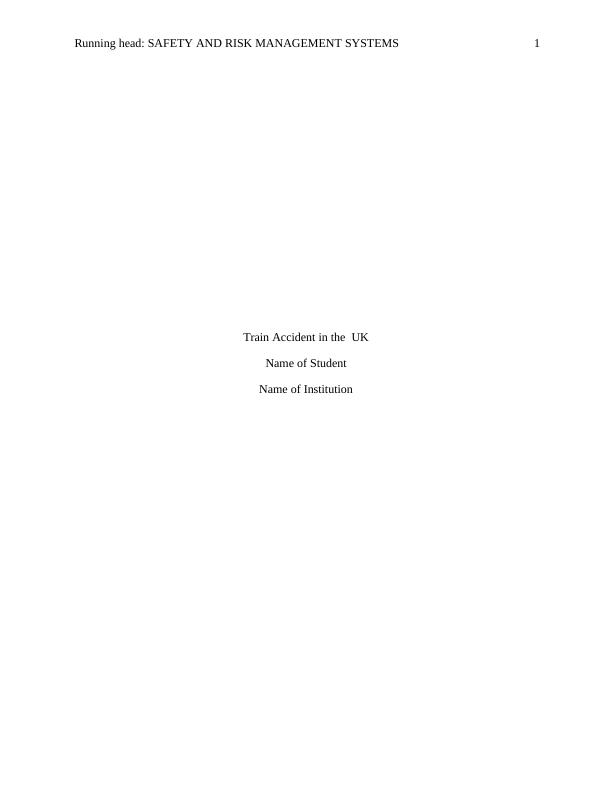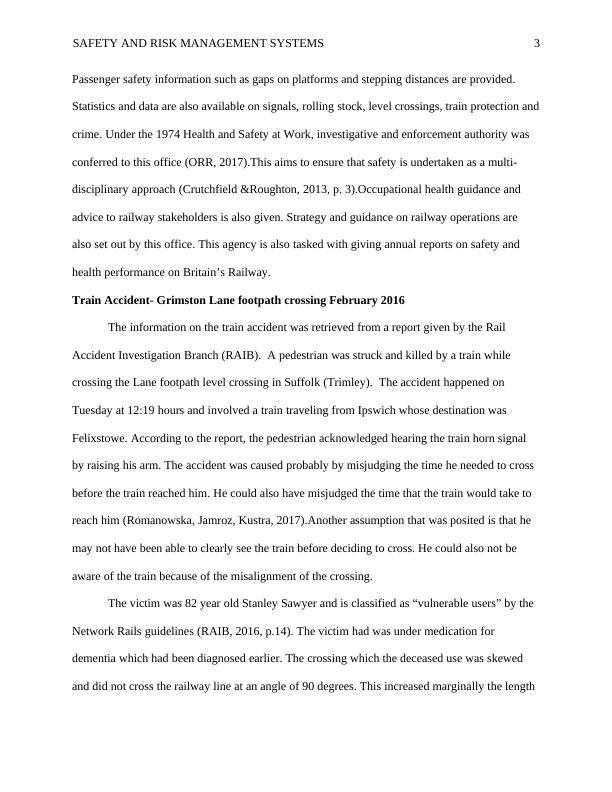Ask a question from expert
Safety & Risk Management System
9 Pages2275 Words267 Views
Added on 2020-03-04
Safety & Risk Management System
Added on 2020-03-04
BookmarkShareRelated Documents
Running head: SAFETY AND RISK MANAGEMENT SYSTEMS 1Train Accident in the UKName of StudentName of Institution

SAFETY AND RISK MANAGEMENT SYSTEMS 2Train Accident in the UKHazards and risks are part and parcel of everyday living both at the workplace and in the private space. Hazards can be defined as conditions that have the potential to cause illness, injuryand deaths. It can also end up with damage of goods and equipment and disrupt operations. Risk can broadly be defined as the probability that hazard will occur and cause injury. Workplaces arereplete with hazards which are attendant with operations of production. Risk and safety management can therefore refer to the sets of processes that are used in formulating and implementing actions to mitigate hazards that are identified. The safety and risk management are dependent on the state legislation and policies that govern the Occupational Health and Safety Plan of each country. The risk and safety policies on train accidents in the UK works under directives set by the EU and transposed into law in the UK.Background on Train Risk and Safety Management in UKThe European Union (EU) policy framework on occupational safety and health (2014-2020) provides the basic framework which has been legislated into law in the UK (EUR-Lex, 2017). The policy defines rules and structures on occupational risks, prevention and safer work environment promotion. The EU further sets out specific regulations that govern the risk and safety management of train operations amongst all member states. Regulation 2016/796 of the European Agency for Railways (ERA) states that guaranteeing high levels of railway transport are part of its core mandate (Biennial Report, 2016, p.1). The agency works with Member states and industry stakeholders in monitoring performance in safety in a multidimensional approach tosafety (Kozuch, &Sienkiewicz-Malyjurek, 2017). Data collected is shared with the National Safety Authorities and investigative bodies of each member state.In the UK the office of Rail and Road is tasked with giving oversight to the railway sector. Health and safety issues are comprehensively addressed by this office (ORR, 2017).

SAFETY AND RISK MANAGEMENT SYSTEMS 3Passenger safety information such as gaps on platforms and stepping distances are provided. Statistics and data are also available on signals, rolling stock, level crossings, train protection andcrime. Under the 1974 Health and Safety at Work, investigative and enforcement authority was conferred to this office (ORR, 2017).This aims to ensure that safety is undertaken as a multi-disciplinary approach (Crutchfield &Roughton, 2013, p. 3).Occupational health guidance and advice to railway stakeholders is also given. Strategy and guidance on railway operations are also set out by this office. This agency is also tasked with giving annual reports on safety and health performance on Britain’s Railway.Train Accident- Grimston Lane footpath crossing February 2016The information on the train accident was retrieved from a report given by the Rail Accident Investigation Branch (RAIB). A pedestrian was struck and killed by a train while crossing the Lane footpath level crossing in Suffolk (Trimley). The accident happened on Tuesday at 12:19 hours and involved a train traveling from Ipswich whose destination was Felixstowe. According to the report, the pedestrian acknowledged hearing the train horn signal by raising his arm. The accident was caused probably by misjudging the time he needed to cross before the train reached him. He could also have misjudged the time that the train would take to reach him (Romanowska, Jamroz, Kustra, 2017).Another assumption that was posited is that he may not have been able to clearly see the train before deciding to cross. He could also not be aware of the train because of the misalignment of the crossing.The victim was 82 year old Stanley Sawyer and is classified as “vulnerable users” by the Network Rails guidelines (RAIB, 2016, p.14). The victim had was under medication for dementia which had been diagnosed earlier. The crossing which the deceased use was skewed and did not cross the railway line at an angle of 90 degrees. This increased marginally the length

End of preview
Want to access all the pages? Upload your documents or become a member.
Related Documents
Risk and Safety Management (Doc)lg...
|9
|2082
|58
Safety and Risk Management Reportlg...
|13
|2512
|6
Waterfall Tragedy: A Case Study on the Failure of Rail Safety Measures in Australialg...
|9
|2257
|244
Occupational Health and Safety at Work – Health and Safety at Workplace Australialg...
|13
|3794
|370
Evaluation of Occupational Health Intervention in Woolworths NZlg...
|12
|3444
|84
Waterfall Train Crash Accident Safety Breach Critical Reviewlg...
|7
|2031
|250